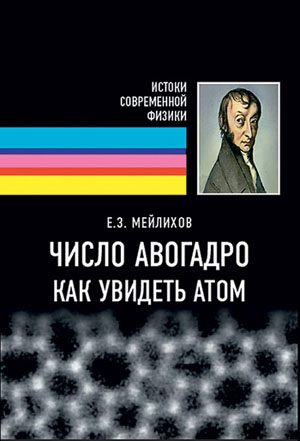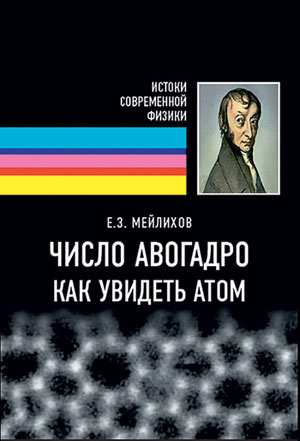Evgeny Meilikhov, Doctor of Physical and Mathematical Sciences “Science and Life” No. 4, 2017 • Library of Scientific and popular articles on “Elements” • Chemistry, history of science, physics
Avogadro and the number of his name
The Italian scientist Amedeo Avogadro-a contemporary of A. S. Pushkin-was the first to understand that the number of atoms (molecules) in one gram atom (prayer) of the substance is the same for all substances. Knowledge of this number opens the way to assess the size of atoms (molecules). During his life, his hypothesis did not receive proper recognition. The story of the number of Avogadro is devoted to the new book of Evgeny Zalmanovich Meilikhov, Professor of the MIPT, chief researcher at the Kurchatov Institute.
If, as a result of any world disaster, all accumulated knowledge would be destroyed and only one phrase would have come to the upcoming generations of living creatures, then what statement made from the least number of words would bring the greatest information? I believe that this is an atomic hypothesis: all bodies consist of atoms – small Tails, which are continuously.
R. Feynman, Feynman lectures in physics
The number of Avogadro (constant Avogadro, constant avogro) is defined as the number of atoms in 12 grams of pure carbon isotope-12 (12 C). It is usually designated as N.Aless often L.. The value of the Avogadro number recommended by CODATA (working group on fundamental permanent) in 2015: N.A = 6.02214082 (11) · 10 23 mol −1. Mol is the amount of substance that contains N.A structural elements (that is, as many elements as atoms are contained in 12 g 12 C), and atoms, molecules, ions, etc. are usually structural elements. According to the definition, the atomic unit of mass (and, i., m.) is 1/12 of the mass Atom 12 C. One moth (gram-can) has a mass (molar mass), which, being expressed in grams, is numerically equal to the molecular weight of this substance (expressed in the atomic units of the mass). For example: 1 sodium mol has a mass of 22.9898 g and contains (approximately) 6.02 · 10 23 atoms, 1 mol of calcium CAF2 It has a mass (40.08 + 2 · 18,998) = 78.076 g and contains (approximately) 6.02 · 10 23 molecules.

At the end of 2011, at the XXIV General Conference on Measures and Libra, it is unanimously accepted to determine the mole in the future version of the international system of units (SI) in such a way as to avoid its link to determining the gram. It is assumed that in 2018, the mol will be determined directly by the number of aviado, which will be assigned an accurate (without error) value, based on the measurement results recommended by Codata. In the meantime, the number of Avogadro is not accepted by definition, but measured by the value.
This constant is named after the famous Italian chemist Amedeo Avogadro (1776–1856), which although he himself did not know, he understood that this was a very large size. At the dawn of the development of the atomic theory, Avogadro put forward a hypothesis (1811), according to which, with the same temperature and pressure in equal volumes of ideal gases, the same number of molecules are contained.Later it was shown that this hypothesis is a consequence of the kinetic theory of gases, and now it is known as the Avogadro law. It can be formulated as follows: one moth of any gas at the same temperature and pressure occupies the same volume, under normal conditions, equal to 22.41383 l (normal conditions correspond to the pressure P.0 = 1 atm and temperature T0 = 273.15 K). This value is known as the molar volume of gas.
The first attempt to find the number of molecules occupying this volume was made in 1865 by J. Loshmidt. From his calculations it followed that the number of molecules per unit volume of air is 1.8 · 10 18 cm −3, which, as it turned out, is about 15 times less than the correct value. Eight years later, J. Maxwell brought a much closer to the truth – 1.9 · 10 19 cm −3. Finally, in 1908, Perren gives an acceptable assessment: N.A = 6.8 · 10 23 mol −1 of the Avogadro number, found from experiments in the Brownian movement.
Since then, a large number of independent methods for determining the number of aviado have been developed, and more accurate measurements have shown that in reality, 1 cm 3 ideal gas under normal conditions contains (approximately) 2.69 · 10 19 molecules. This value is called Loshmidt (or constant). It corresponds to the number of aviado N.A ≈ 6,02 · 10 23 .
The number of Avogadro is one of the important physical constant, playing a large role in the development of natural sciences. But is it “universal (fundamental) physical”? This term itself is not defined and is usually associated with a more or less detailed table of numerical values of physical constants that should be used in solving problems. In connection with this fundamental physical constant, those values that are not constants of nature are often considered to be only the chosen system of units (such, for example, magnetic and electric constant vacuum) or conditional international agreements (such, for example, an atomic unit of mass) . The fundamental constants often include many derivatives (for example, a constant gas R, classic electron radius rE. = E. 2 / mE.C. 2, etc.) or, as in the case of a molar volume, the value of a certain physical parameter related to specific experimental conditions, which are selected only for reasons of convenience (pressure 1 atm and temperature 273.15 K). From this point of view, the Avogadro number is a truly fundamental constant.
The history and development of methods for determining this number is devoted to this book. The epic lasted about 200 years and at different stages was associated with diverse physical models and theories, many of which have not lost relevance to this day. The lightest scientific minds attached a hand to this story – it is enough to name A. Avogadro, J. Loshmidt, J. Maxwell, J. Perren, A. Einstein, M. Smolukhovsky. The list could be continued.
The author must admit that the idea of the book does not belong to him, but to Lev Fedorovich Soloveichik-his classmate at the Moscow Physics and Technology Institute, a person who was engaged in applied research and developments, but remained a romantic physicist in his soul. This is a person who (one of the few) continues “and in our cruel century” to fight for the real “higher” physical education in Russia, appreciates and to the best of strength promotes the beauty and grace of physical ideas. It is known that from the plot, which A. S. Pushkin gave N.V. Gogol, a brilliant comedy arose. Of course, this is not the case, but maybe this book will seem useful to someone.
This book is not a “popular science” work, although it may seem like that at first sight. On a certain historical background, serious physics is discussed, serious mathematics is used and rather complex scientific models are discussed. In fact, the book consists of two (not always sharply delimited) parts designed for different readers-it may seem interesting from a historical and chemical point of view, while others may focus on the physical and mathematical side of the problem. The author had in mind the curious reader – a student of the physical or chemical faculty, not alien mathematics and enthusiastic about the history of science. Are there such students? The author does not know the exact answer to this question, but, based on his own experience, he hopes that there is.
Introduction (in reduction) to the book: Meilikhov E. Z. The number of avogadro. How to see an atom. – Dolgoprudny: ID Intellect, 2017.
